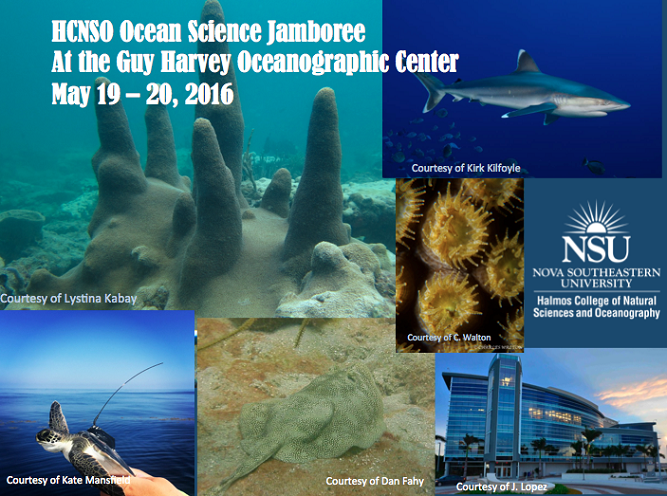A bank divided: quantifying the spatial-temporal connectivity break on the Campeche Bank
Location
Guy Harvey Oceanographic Center Facility
Start
5-19-2016 2:30 PM
End
5-19-2016 2:45 PM
Abstract
Marine connectivity over seascapes enables the persistence of metapopulations and is often regulated in part by an organism’s pelagic larval duration (PLD), fecundity, mortality, and ocean conditions. The Campeche Bank (CB) in the southern Gulf of Mexico flanks the strong-flowing Loop Current and is important ecologically and economically in the context of mesoscale connectivity to the Gulf. A biophysical model was used to examine connectivity between the CB and the north-eastern Gulf (NEGOM) of simulated populations of lionfish (Pterois volitans/miles), red grouper (Epinephelus morio), black sun coral (Tubastrea micrantha), and a generic marine organism. The purpose was to assess longitudinal connectivity across the bank to the NEGOM and also to quantify this connectivity over a range of PLDs and organism fecundities. From this work, portions of the north-eastern perimeter of the CB in water depths between 50-300 m were forecasted as the majority sources of lionfish and red grouper recruits to the NEGOM. This finding is important as deep waters on the bank are often heavily targeted by commercial fishers and are also beyond the reach of present lionfish control regimes. We also demonstrate that buoyant larvae must remain in the water column for a minimum of ten days to reach the NEGOM from the CB given prevailing water flow, though 45-50 days provides maximum connectivity. These findings are relevant for invasive species control, fisheries management, ecosystem services, and to preserve metapopulations of marine fauna sympatric to the both regions.
A bank divided: quantifying the spatial-temporal connectivity break on the Campeche Bank
Guy Harvey Oceanographic Center Facility
Marine connectivity over seascapes enables the persistence of metapopulations and is often regulated in part by an organism’s pelagic larval duration (PLD), fecundity, mortality, and ocean conditions. The Campeche Bank (CB) in the southern Gulf of Mexico flanks the strong-flowing Loop Current and is important ecologically and economically in the context of mesoscale connectivity to the Gulf. A biophysical model was used to examine connectivity between the CB and the north-eastern Gulf (NEGOM) of simulated populations of lionfish (Pterois volitans/miles), red grouper (Epinephelus morio), black sun coral (Tubastrea micrantha), and a generic marine organism. The purpose was to assess longitudinal connectivity across the bank to the NEGOM and also to quantify this connectivity over a range of PLDs and organism fecundities. From this work, portions of the north-eastern perimeter of the CB in water depths between 50-300 m were forecasted as the majority sources of lionfish and red grouper recruits to the NEGOM. This finding is important as deep waters on the bank are often heavily targeted by commercial fishers and are also beyond the reach of present lionfish control regimes. We also demonstrate that buoyant larvae must remain in the water column for a minimum of ten days to reach the NEGOM from the CB given prevailing water flow, though 45-50 days provides maximum connectivity. These findings are relevant for invasive species control, fisheries management, ecosystem services, and to preserve metapopulations of marine fauna sympatric to the both regions.


